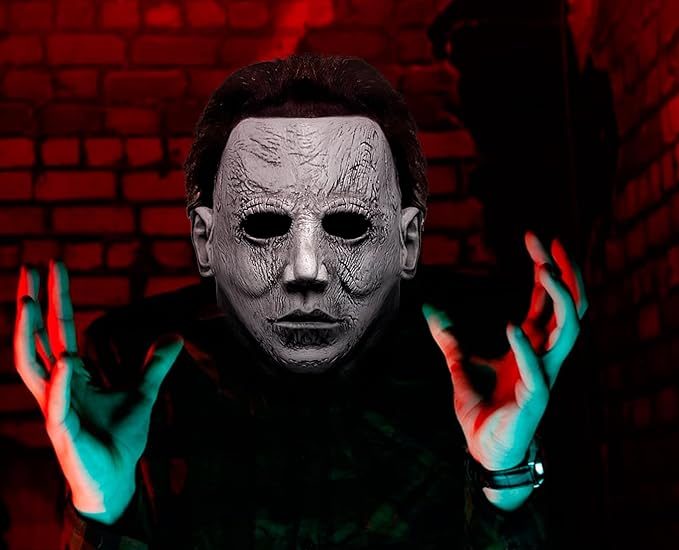The Michael Myers mask is an iconic symbol of horror and suspense, most famously seen in the Halloween film franchise. This article delves into the eerie world of the Michael Myers mask, exploring its origins, the cultural impact it has made, the significance of its design, the enduring fear it instills, the influence on popular culture, and the lasting legacy of this terrifying mask.

I. The Origins of the Michael Myers Mask
1.1 The Creation of a Menacing Persona:
The Michael Myers mask was first introduced in John Carpenter’s 1978 film, Halloween. The mask, originally a Captain Kirk mask painted white, was chosen to create an emotionless and chilling appearance for the character of Michael Myers. This decision laid the foundation for the mask’s enduring legacy.
1.2 Transformation into a Horror Icon:
The mask played a pivotal role in transforming Michael Myers into one of the most recognizable and feared horror villains of all time. The blank, expressionless face became synonymous with evil and unrelenting terror, captivating audiences and leaving a lasting impression.

II. The Cultural Impact of the Michael Myers Mask
2.1 Shaping the Slasher Genre:
The Michael Myers mask played a significant role in shaping the slasher genre of horror films. Its haunting and emotionless presence set a new standard for the portrayal of masked villains, inspiring countless imitations and establishing a template for future horror films.
2.2 Enduring Fear and Nightmares:
The image of the Michael Myers mask has become deeply ingrained in popular culture, instilling fear and nightmares in audiences around the world. The mask’s unsettling and emotionless visage has the power to evoke a primal sense of dread, leaving a lasting impact on viewers long after the credits roll.

III. The Design of the Michael Myers Mask
3.1 Iconic Features and Characteristics:
The design of the Michael Myers mask is instantly recognizable and has become synonymous with the character’s menacing presence. Its pale complexion, combined with the absence of human emotions, creates a chilling and otherworldly appearance. The mask’s simple yet effective design captivates viewers, drawing them into the eerie world of Michael Myers.
The dark, hollow eyes of the mask are particularly striking, as they lack any signs of life or emotion. They seem to peer into the depths of the viewer’s soul, instilling a sense of dread and uncertainty. The wide, expressionless mouth adds to the mask’s haunting allure, leaving observers with an unsettling feeling that something sinister lurks behind it.
3.2 Psychological Effect on Viewers:
The design of the Michael Myers mask taps into the deep-rooted fear of the unknown and the uncanny that resides within the human psyche. Its expressionless features evoke a sense of ambiguity, making it difficult for viewers to gauge the character’s intentions or emotions.
This ambiguity creates a psychological effect on viewers, leaving them in a state of unease and anticipation. The lack of emotional cues in the mask denies viewers the ability to empathize or connect with the character, intensifying the sense of mystery and malevolence that surrounds Michael Myers. It leaves them questioning the motives and intentions of this seemingly emotionless and unstoppable force, heightening the tension and fear experienced while watching the film.
The psychological impact of the Michael Myers mask is further enhanced by its association with the horror genre and its use in frightening and suspenseful scenes. As the mask becomes intertwined with the character’s actions and the atmospheric setting of the film, it amplifies the sense of terror and leaves a lasting impression on viewers.
In conclusion, the design of the Michael Myers mask is iconic and instantly recognizable. Its pale, blank expression and the absence of human emotions create a chilling and uncanny presence. The mask’s simple yet effective design taps into the primal fear of the unknown, leaving viewers in a state of unease and anticipation. Its psychological impact, combined with its association with the horror genre, solidifies its place as one of the most iconic and chilling masks in cinema history.

IV. The Influence of the Michael Myers Mask on Popular Culture
4.1 Halloween Costume Staple:
The Michael Myers mask has become a Halloween costume staple, with fans donning the mask to pay homage to the iconic character. The mask’s popularity extends beyond horror enthusiasts, making it a recognizable and widely used costume choice.
4.2 Memorable Pop Culture References:
The Michael Myers mask has been referenced and parodied in various forms of popular culture, from films and television shows to music and art. Its distinct appearance has seeped into the collective consciousness, becoming a symbol of horror and a reference point for the genre.
V. The Lasting Legacy of the Michael Myers Mask
5.1 Cult Following and Fan Devotion:
The Michael Myers mask has garnered a dedicated cult following, with fans expressing their devotion through fan art, conventions, and online communities. The mask’s enduring popularity speaks to its ability to captivate and terrify audiences across generations.
5.2 Influence on Subsequent Horror Films:
The influence of the Michael Myers mask extends beyond the Halloween franchise, inspiring the design of other iconic horror villains. Its impact can be seen in the creation of characters like Jason Voorhees in Friday the 13th and Ghostface in Scream, solidifying its legacy as a symbol of horror cinema.

The Michael Myers mask stands as a chilling and iconic symbol of horror cinema. Its origins in the Halloween franchise, along with its emotionless design and lasting cultural impact, have solidified its place in the annals of horror history. The mask’s ability to instill fear, its influence on popular culture, and its enduring legacy make it a timeless and unforgettable icon in the world of horror.




